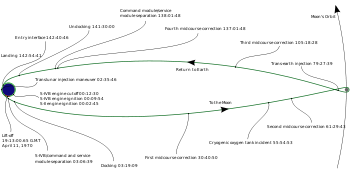- Circumlunar trajectory
-
A Circumlunar trajectory, Trans-Lunar trajectory or Lunar free return is a type of free return trajectory which takes a spacecraft from Earth, around the far side of the Moon, and back to Earth.
Background
The first spacecraft to fly a circumlunar trajectory was Luna 3. Circumlunar trajectories were also used by Apollo missions prior to lunar orbit insertion,[1] to provide a free return to Earth in the event of a propulsion system malfunction on the way to the Moon. This was used on Apollo 13, when an oxygen tank rupture necessitated return to Earth without firing the Service Module engine, although a number of course corrections using the Lunar Module were required to maintain this trajectory.[2]
A number of manned missions were also proposed to intentionally conduct circumlunar flybys, including the Soviet Soyuz 7K-L1 or Zond programme, and several US proposals, including Gemini-Centaur and an early Apollo proposal.[3]
See also
References
- ^ "The launch and mission trajectory". Apollo 13 Mission Report. Spaceflight Now. http://spaceflightnow.com/apollo13/retro/09/launch.html. Retrieved 2009-06-30.
- ^ Turnhill, Reginald. "Apollo 13 on Free Return Trajectory". Spaceflight Now. http://spaceflightnow.com/apollo13/retro/14/index3.html. Retrieved 2009-06-30.
- ^ Wade, Mark. "Manned Circumlunar". Encyclopedia Astronautica. http://www.astronautix.com/craftfam/manlunar.htm. Retrieved 2009-06-30.[dead link]
Categories:- Exploration of the Moon
- Space stubs
Wikimedia Foundation. 2010.

